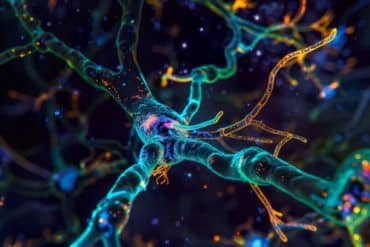Summary: Tamapin, an investigational drug derived from Indian red scorpion venom, reverses motor deficits in pre-clinical models of fetal alcohol spectrum disorder.
Source: Children’s National Hospital
A research team led by Children’s National Hospital faculty was able to “rescue” a pre-clinical model of fetal alcohol spectrum disorder (FASD) in juvenile models, reversing motor skill deficits with the help of a novel drug derived from scorpion venom. The finding, in the Nature Neuroscience, could offer hope to an estimated 119,000 children born with this condition worldwide each year.
FASD, caused by alcohol consumption during pregnancy, causes numerous learning disabilities, including cognitive and intellectual deficits. Motor skills problems can be an early indicator for these other issues, explains study leader Kazue Hashimoto-Torii, Ph.D., a principal investigator at the Center for Neuroscience Research at the Children’s National Research Institute. Many parents and caregivers first notice a problem when babies show delays in achieving motor developmental milestones. Although these effects are well documented, Hashimoto-Torii adds, it’s been unclear what molecular mechanisms cause these deficits.
Hashimoto-Torii has been studying these effects ever since her postdoctoral training when, pregnant herself; she became interested in the consequences of environmental exposures on development. Over the past several years, she and colleagues have published a series of papers toward understanding FASD’s molecular mechanisms.
In the most current paper, her team worked with a pre-clinical model of FASD in which gestating fetuses were exposed to alcohol at embryonic days 16 and 17, a period in which brain cells grow predominantly in the upper cortex, a brain region that plays a key role in motor abilities. This embryonic period corresponds to early mid-gestation in human fetuses.
When the researchers tested these pre-clinical models 30 days after birth–in two exams designed to assess both large– and small-muscle motor skills–they showed significant deficits in both areas. Searching for the molecular differences that might underlie this diminished performance, the researchers found that prenatal alcohol exposure immediately activated a signaling pathway known as “heat shock,” which causes cells to produce protective proteins. These heat shock proteins were produced randomly in some cells, rather than uniformly throughout the cell population.
Using a pre-clinical model that allowed them to track the descendants of these rapidly dividing neurons, the team found differences in the expression of 93 genes. One gene in particular, known as Kcnn2, which encodes a calcium-activated potassium channel, was over-expressed in the cells that produced heat shock proteins. This gene already has been implicated as playing an important role in learning and memory. Cells in which Kcnn2 was over-expressed showed abnormal firing patterns.

When the researchers administered a drug that blocks this channel, known as Tamapin, derived from Indian red scorpion venom, the affected cells’ firing patterns reverted to normal. More importantly, pre-clinical models that received this drug at 30 days of life showed marked improvements in both large- and small-muscle motor skills. The fact that the pre-clinical models could still show improvements long after the initial damage suggests that treatment for children with FASD with a similar agent might also be effective, says Hashimoto-Torii. To that end, she and colleagues have launched a biotech company to further investigate this drug to see if it might hold promise in humans.
“Usually investigators looking for the molecular mechanisms behind disease stop there, but we want to move forward to have a real impact on public health,” she says. “We really want to give patients the hope of having a better life through treating the neurodevelopmental problems caused by FASD.”
Other Children’s National researchers who contributed to this study include Shahid Mohammad, Stephen J. Page, Li Wang, Seiji Ishii, Peijun Li, Toru Sasaki, Aiesha Basha, Zenaide Quezado, Joshua Corbin, and Masaaki Torii.
Funding: Funding for this study was provided by the Scott-Gentle Foundation
Source:
Children’s National Hospital
Media Contacts:
Jamel Langley – Children’s National Hospital
Image Source:
The image is credited to Dinesh Valke, licensed CC BY SA 2.0.
Original Research: Open access (PDF)
“Kcnn2 blockade reverses learning deficits in a mouse model of fetal alcohol spectrum disorders”. Shahid Mohammad, Stephen J. Page, Li Wang, Seiji Ishii, Peijun Li, Toru Sasaki, Aiesha Basha, Anna Salzberg, Zenaide Quezado, Fumiaki Imamura, Hirotaka Nishi, Keiichi Isaka, Joshua G. Corbin, Judy S. Liu, Yuka Imamura Kawasawa, Masaaki Torii & Kazue Hashimoto-Torii.
Nature Neuroscience doi:10.1038/s41593-020-0592-z.
Abstract
Kcnn2 blockade reverses learning deficits in a mouse model of fetal alcohol spectrum disorders
Learning disabilities are hallmarks of congenital conditions caused by prenatal exposure to harmful agents. These include fetal alcohol spectrum disorders (FASDs) with a wide range of cognitive deficiencies, including impaired motor skill development. Although these effects have been well characterized, the molecular effects that bring about these behavioral consequences remain to be determined. We previously found that the acute molecular responses to alcohol in the embryonic brain are stochastic, varying among neural progenitor cells. However, the pathophysiological consequences stemming from these heterogeneous responses remain unknown. Here we show that acute responses to alcohol in progenitor cells altered gene expression in their descendant neurons. Among the altered genes, an increase of the calcium-activated potassium channel Kcnn2 in the motor cortex correlated with motor learning deficits in a mouse model of FASD. Pharmacologic blockade of Kcnn2 improves these learning deficits, suggesting Kcnn2 blockers as a new intervention for learning disabilities in FASD.






